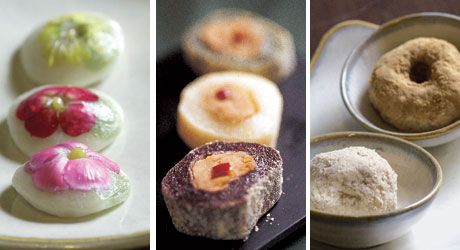(Small businesses) Ttôk is being modernized, too
Chosun Ilbo has a story of a ttôk (rice cake) company that's begun to develop new kinds of ttôk (ddeok), to "make a distinction from neighborhood ttôk bakeries." The founder of the company is the head of the Institute of Traditional Korean Food; she is not going to make her ttôk business a franchise despite of the continuous requests, but once the problem of transporting raw material is solved, she'd like to open branch shops in Tokyo and New York. (Distinction from neighborhood ttôk bakeries indeed!)이들은 자체 개발한 떡을 2000∼3000원짜리 포장으로 낱개 판매하거나 전통차와 함께 제공하는 등 고급스러운 분위기의 떡카페를 운영하기도 한다. 호원당의 경우 미국 LA 한인촌을 중심으로 1ㆍ2·3호점까지 열어 떡의 세계화를 위한 기반을 다지고 있다.  Mrs Yun, the head of the institute, noticed that in order to truly internationalize ttôk, there are many hurdles to cross for ttôk to be liked by "foreigners". First, foreigners are not used to bite off pieces (peô môkta), so the cake must be small enough to be eaten with one bite. Second, ttôk-covering powder (komul) drops off, so it cannot be eaten in a dignified (chômjanhûn) place. Third, foreigners don't like the glutinous rice that sticks to the teeth, so ordinary milled rice should be used. A sentence that cannot be left unquoted: 하지만 입맛이 현대화되면서 떡은 점점 대중과 멀어져 갔다. "But as people's tastes are getting modern, ttôk is becoming estranged from the public." Here the development of new kinds of ttôk and adjusting the traditional food to the "modernized tastes" is connected to the "wellbeing boom".  Here I cannot but think Mr Pak and his rice cake bakery in "my neighborhood". He and his wife have decided not to make things like what was explained above, not to "develop" anything or expand - that's on the other hand typical due to the limitations of doing a "neighborhood business", but also due to their decision not to make ttôk ready for customers but take only orders. It just isn't worth it, doesn't pay off and takes away time to spend with friends. But I guess Mrs Yun's ttôk place is not as internationalized as Mr Pak's pangakan, as can be seen in the picture. In fact Mr Pak said he'd like to come to Finland to keep a ttôk place - I would've been his marketing director - but he's yet to realize his grand plan. (He also suggested I send an airplane to pick them up to attend my wedding, but also that came to nought.) Categories at del.icio.us/hunjang: neighborhood ∙ Koreanculture ∙ Koreansociety ∙ modernization |


